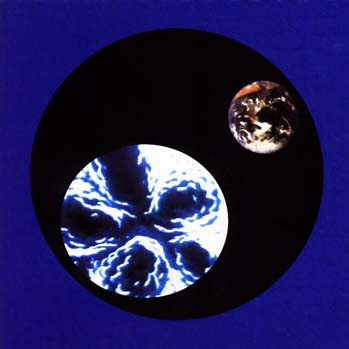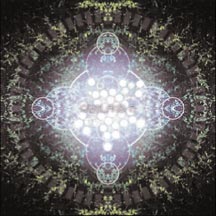BILL LASWELL & PETE NAMLOOK




African Virus
(Electronic Sonata with a Cold Loved by Nature)
1/ Part I (Laswell,Namlook) 9.30
2/ Part II (Laswell,Namlook) 9.28
3/ Part III (Laswell,Namlook) 18.09
4/ Part IV (Laswell,Namlook) 5.48
5/ Part V (Laswell,Namlook) 6.08
6/ Part VI (Laswell,Namlook) 10.15
Recorded at Klanglabor, Frankfurt, Germany
Ethnic sounds recorded in West Africa by Oz Fritz
Produced by Peter Kuhlmann
Bill Laswell: sounds; Pete Namlook: sounds.
1996 - FAX +49-69/450464 (Germany), PW 28 (CD)
2002 - Ambient World (Germany), AW 025 (CD)
We begin with some darker tones. Heavily saturated drones, much like some of the work in the first Outland. Cavelike, eerie, almost sinister. You didn't come here for merriment did you? Lie back, and take this in. Entire villages were consumed by this menacing virus, and you're in your deep chair about to absorb one of the better Faxlabel offerings. A little emotional deference in the name of global consciousness isn't too much to ask. And besides, lots of us really dig this oppressive darkambient stuff!
You know from the sound of voices that you've begun part 2. What sounds like West African marketplace ambience funnels into the lulls of part 1. I hear the pleasant trails of a distantly reverberating stringed instrument. A nice blend here, and with a keen ear you might recognize some of the environmental ambience and talking from parts of Laswell's "Oscillations" series of discs. Toward the end of this section, another remote voice emerges, chanting praise while the drones become more continuous. It's all beatless up to this point.
Now for part 3, we leave the countryside and enter the studio for a more structured variation on ethno-trance. This one begins with a vivid Middle Eastern soundbyte you might recognize from the groundbreaking Excursions in Ambience II compilation (that compilation put the Orb, Maurizio & Fehlmann, Locust, and Laswell on one disc!) The track was "Praying Mantra," which must have been an electronic landmark for Laswell, as you can also find other elements from that track on yet another album, his Benares "City of Light." It's reworked here a little bit with the sequencer. The common thread between all of these, of course, is the trancey blend of ethnic percussion and melodic patterning. Part 3 really stands out, as the beat is fierce. And checking in at just over 18 minutes, the track is about twice as long as any of the others. There's plenty of surprise stunts throughout. Keyboards, drum patterns, and solo instruments all get exclusive time at some point during this piece. At 7:51, you're sent gliding into the stratosphere, high above Africa's highest point, Mount Kilimanjaro, and what a magnificent view it is. The synth now dominates the track, and then the beat kicks back in. What a ride! Laswell's rugged bass rips through the synthesized smoothness, as if it was the mountainous landscape itself. When all the elements come together in this track, it really shines. At 13:53 you are once again shuttled high into the atmosphere, but this time you won't be coming back.... and with 90 seconds left, the memory of our chanting friend returns.
In part 4, you might get another dose of deja vu. Where have I heard this before, you might ask yourself. Check your Sultan "Osman" disc, that should help. Slightly different timing or tuning, but the similarity is definitely there. This disc was released long before Osman was out, and here we get an accompanying ethnic instrument to go along with it. These swirling textures lend some optimism to a generally dark disc. At just under 6 minutes, this is the album's shortest track.
The environmental recordings of Oz Fritz get the spotlight here in part 5. The marketplace ambience emanates once again, but here combined with some downtempo drum loops. The percussion is organic sounding, like the rest of the album, rather then the more obvious electronic variety. Part 5 rolls for just over 6 minutes, and listen carefully toward the end, as there are some close-up conversational field recordings.
The ender goes back to the drones of part 1, but this time it's more like the tones gently rotate. Set us back down gently boys, nice touch! ;-)
I can see what this disc is trying to do, Laswell wants us to take a trip into a mental state that combines a dreamlike awareness with an imagined African, possibly spirtual, landscape. This involves taking us on a journey split into five segments. In general fairly subtle and possible disturbing noises, including field recordings of the African 'outland' itself, are used to good effect. From here the piece builds in the mid section into a full-on tribal rhythm/bass line which is pretty good played as a dance track on its own. I know this part has put those who loved Outland 1 off but for me this works well. From here the disc descends into the slightly metallic bass laden wind chime effect which effectively chills us back out again. A solid FAX release which rises above much of the monochrome and sometimes 'thin' sound pallette that I think dogs some of their releases.
Rowland Atkinson
In this highly notable outing, Pete Namlook and Bill Laswell portray the cycle of a day in the African Outland. The consecutive scenes of this 60-minute sonic documentary seem to describe the various phases of the sun, beginning in the dusky area before sunrise to end up back in the darkness of night. This "African Sonata" features extensive use of the intriguing field recordings of one Oz Fritz. These recordings display human existence in the Outland, an existence seemingly long-lived and yet fragile. These recordings occur throughout the majority of the work and tie it together nicely with a continuous contextual theme. This disc also highlights the classic improvised keyboard vignettes of Namlook, used reservedly and effectively, and in combination with the electric-primitive percussion which permeates many of the passages, "Outland 2" is one of the most successful and cohesive collaborations between Namlook and Laswell that I've experienced.
A melancholy tide of keyboard ambient calls out from a dark space to open the disc and display the Outland in pre-sunrise gloom. Clear and deep tones harmonically converse with a foreboding resonation in a slow motion dance. The spatial track swirls in grey murkiness and the stars begin to fade as the world brightens. A touching piece which heralds the stately arrival of the sun. As the sun slips above the horizon, the world filters into hazy morning and a human settlement is revealed. Part II, a 10-minute piece, is the longest look we get at Fritz's recordings, and things shift from echoing voices, bells, instruments, and variously unrecognizable noise, all backed with the ever present morning sun climbing higher and higher in the sky. Persistent and ethereal-sounding chants strain through the dusty haze and the day begins to heat up. Despite the human comfort of these sounds, there is a primal undercurrent of menace here that seldom fades away. Deep rumbles and unsettling gusts of harsh sand-sound intersperse periodically. Ancient and celebratory sounds emanate from all different locations of the landscape but merge with the solar tide to create a bipolar sense of unease and beauty. Glassy sheets of harmony close out our glimpse into society as we leave civilized territory and head for the Outland itself. In Part III, the sun has reached its zenith and fittingly the disc here attains its highest concentration of energy. An 18-minute excursion into the rugged landscape ensues as the sun beats down, heating hearts, and atoms feel the primitive power of the light. Electronic-tinged tribal-esque percussion drives and pounds its way through savanna air currents, constantly recombining, intermittently backed with ambient expanses, commanding analog tones, and clean-edged ethnic instrumentation. Periodic drop-offs allow for this drawn-out track to discover new terrain, exploring and speeding. Being a primarily rhythmic piece, this track's virtue lies not so much in its aesthetic sense but rather its constant re-patternization of elements and well-chosen refusal to retread the same ground too often. Thankfully the pounding journey slows at the 14 minute mark and we're treated to a stretch of Namlook's octave-scaling sequences and a revisitation of the field recordings of Part II as the sun edges into afternoon. We immediately glide into a marching progression of dramatic synth chords which merge with a growing metallicized gamelan-sounding loop. These alternately accent and harmonize with each other, surging and fading in a radiant concourse. The sun begins to descend and illuminate the Outland in golden shades of sunset as this rather brief Part IV fades off. After a moment of silence, our rhythmic loop returns but this time as a washed out and echoing reprise. Flattened shades of purplish grey shorten our focus as dry twilight deepens and Part V begins. Soon, machines-cum-rocks/sticks/drums form a panning and rhythmic form of sound sculpture. A very raw and unusual piece that's periodically textured with more sonic glimpses into the lives of the humans of the Outland. Simple but off-set and boldly designed, percussive echoes knock through painted caves and out from shadows. I'm glad our duo chose this unforeseen direction as it adds a nice mind-bender and an interesting twist to the disc… The stars are out as the land is again enveloped in darkness. This reprise of the first track feels much more serene but one can still very presently feel the churning of the vast Earth beneath. Organisms' consciousness is exhaled into the black sky as the land sleeps. Part VI is a deep and reserved piece of ambient that bookends and closes the disc in emotional, starlit fashion.
Auraphage